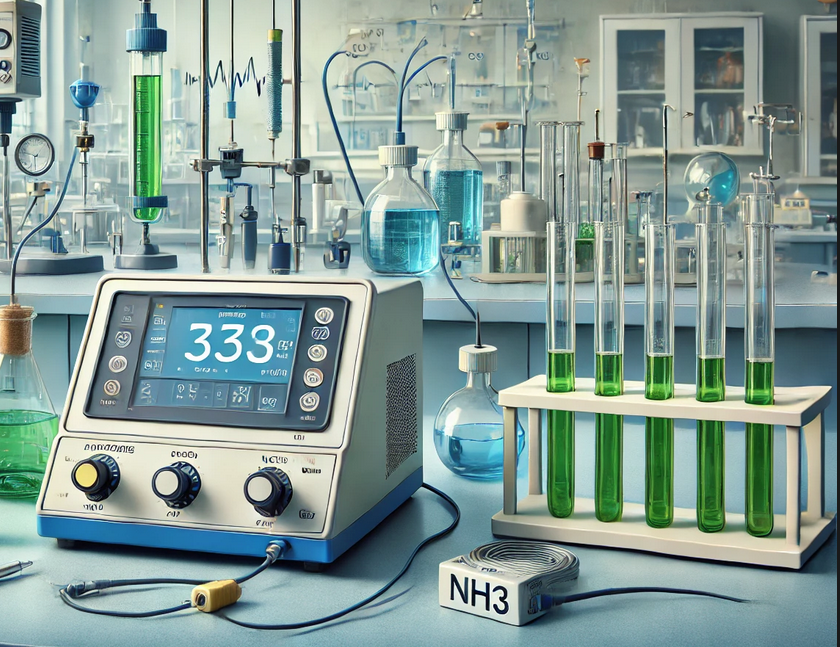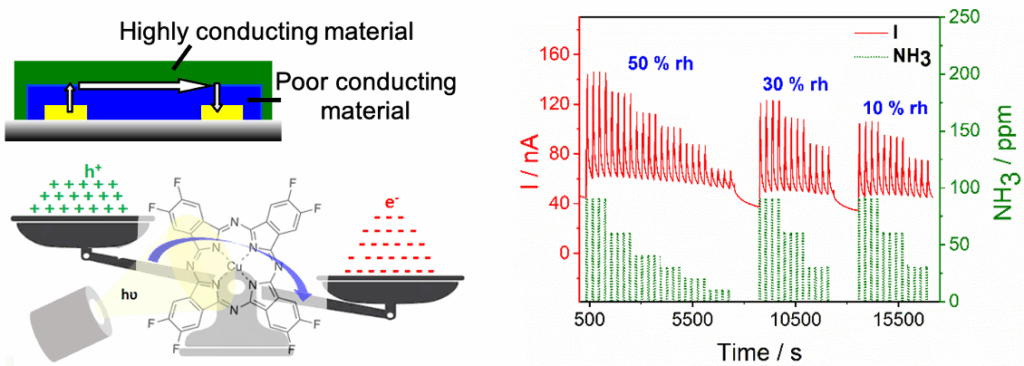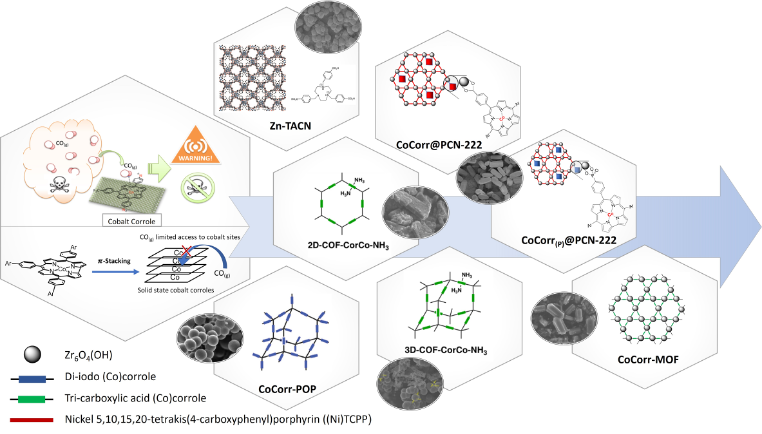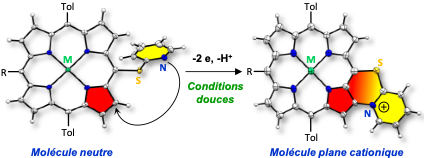
EQUIPE EMCAP
ElectrochEMISTRY, MatEriAL, Coordination, AnalysIS AND Porphyrinoïds
Scientific context and objectives
The EMCAP team’s research activities focus on molecular materials, ranging from molecules to materials and materials to devices. The molecules (porphyrinoids such as corroles, porphyrins, sapphyrins and phthalocyanines, bioinspired siderophores and siderochelates); materials (such as COF, POP, MOF, nanoporous gold electrodes and electrodes modified by the electroreduction of diazonium salts or electropolymerization) and devices (conductometric sensors (resistors and heterojunctions) or acoustic sensors (SAW)) are used for analytical purposes, such as the detection of CO, NH₃, ozone, sulfites, phenol derivatives, and U(VI), as well as in the field of health (decorporation of actinides and theranostic agents). Electrochemical techniques are employed for the synthesis, immobilization and detection of chemical or biological species. The synthesis and electrosynthesis fields cover various compound families, such as pyrrolic macrocycles (corroles, sapphyrins, porphyrins, and phthalocyanines), bioinspired siderochelates, and nitrogen chelators. They also involve electropolymerization, polymer functionalization and surface functionalization.
Team members
Team leader: Pr. Charles DEVILLERS
- Dr. Laurie ANDRÉ (CR, CNRS)
- Pr. Marcel BOUVET (PU)
- Dr. Nicolas DESBOIS (MCF HDR)
- Pr. Claude GROS (PU)
- Pr. Dominique LUCAS (PU)
- Dr. Michel MEYER (CR HDR, CNRS)
- Dr. Rita MEUNIER-PREST (CR HDR, CNRS)
- Dr. Jean SUISSE (MCF)
- Dr. Stéphane BRANDÈS (IR, CNRS)
- Sophie FOURNIER (TCH, UBE)
- Sandrine PACQUELET (TCH, UBE)
Research topics
TOPIC 1: Materials and nitrogen-based ligands for analysis
Find out more about our 4 research topics:
Gas sensors based on molecular materials
We are developing sensors capable of detecting ozone (O3) on the ppb scale to meet air quality monitoring criteria (10 – 200 ppb) and ammonia (NH3) with a detection limit below ppm, for applications not only in the food industry (eg. 30 -300 ppm in cheese maturing cellars), but also in breath analysis (a few tens of ppb for healthy people, but up to around 1 ppm in cases of liver or kidney dysfunction).
As conductometric transducers, we mainly study bilayer devices, the top layer being highly sensitive, while the underlayer enables us to control the nature of the majority charge carriers circulating in the device, as demonstrated in a device we have patented (Fig. 1 top left). Thanks to the formation of an accumulation channel at the interface between the two materials, heterojunction devices offer greater sensitivity and stability than conventional resistors. The electrografting of substituted benzene rings has made it possible to modulate the work output of the electrodes and increase the barrier energy of the device, inducing a modification of the electrical and sensing properties. We are currently focusing on the study of ambipolar conductometric sensors, capable of operating in two states, p-type and n-type. We have demonstrated the polarity inversion of octahalophthalocyanine -based heterojunctions under visible light (Fig. 1, bottom left). The use of fluorinated phthalocyanines as sublayer also offers the advantage of limiting sensitivity to variations in relative humidity (Fig. 1 right).

MOF/COF/POP porous materials
Our activity focuses on the development of new porous metal-organic materials (e.g. Metal-Organic Framework) or organic materials (Covalent Organic Framework, Porous Organic Polymer), applied to gas detection/capture, heterogeneous catalysis or for their antibacterial properties. These materials form crystalline or structured microporous networks and are made up of sensitive organic molecules introduced by direct synthesis or by post-functionalization of the material, thus conferring the targeted property. At present, our work is focused on the synthesis of new materials including porphyrin derivatives, such as metallocorroles. In particular, cobalt corroles are sensitive and selective to ammonia (NH3) or carbon monoxide (CO) in the presence of other gases such as N2, O2 or CO2. Several cobalt corroles have been grafted into the PCN-222 MOF structure thanks to the MOF’s natural vacancies on its Zirconium cluster. In another case, several COFs and a MOF were synthesized directly from cobalt corroles.
Optimizing the moisture resistance of our materials is another focus of our work, which we are seeking to address through the development of hydrophobic core-shell-like structures. Improved moisture resistance will make our materials more durable and extend their applications.
These materials are characterized by techniques available in our laboratory (sorptometry, DRX on powder or single crystal, ATG/DSC, NMR and infrared spectroscopies) or in a platform dedicated to materials analysis (XPS, SEM).

Physical chemistry of coordination: molecular engineering, speciation and kinetics
Our work focuses on the synthesis of original chelators and the structural, thermodynamic and kinetic study of the formation and dissociation equilibria of metal complexes in solution. At the interface of coordination chemistry, environmental chemistry, health and nuclear medicine, the cross-disciplinary research orientations of the “Physico-chemistry of coordination” thematic axis concern:
– The development and synthesis of bioinspired sequestrants of siderophores with cyclic hydroxamic units and free or grafted nitrogen chelators;
– The coordination chemistry of metal cations, in particular those of groups d and f (lanthanides and actinides) in an environmental and medical context;
– Molecular recognition for separation/purification and detection of toxic metal cations.
In the environmental field, our ligands are used in a variety of processes, such as solid/liquid extraction, in natura preconcentration of trace-level radioelements (specific resins for DGT sensors), and actinide soil/plant transfer.
In healthcare, they meet medical needs as theranostic agents for emerging radionuclides in oncology, or as actinide decorporants as countermeasures in case of poisoning by ingestion or inhalation.

Electrochemical surface modification for analysis
Various surface modification techniques have been developed, such as electropolymerization, aryl-diazonium electroreduction and the self-assembly of thioalkane monolayers on a gold electrode (Self-Assembled Monolayers, SAM).
Concerning electropolymerization, the oxidation of various types of monomer (aniline, pyrrole, porphyrin derivatives, etc.) leads to original functional materials.
Electroreduction of aromatic diazoniums (based on phenyl, porphyrins…) produces the corresponding aryl radicals, which react with the electrode surface to form covalent bonds.
Thioalkane SAMs are generally produced by passive adsorption. We have found that deposition at an imposed potential is much more selective and rapid than the passive adsorption route.
These different materials are characterized using surface characterization techniques available in our laboratory (electrochemistry, spectroelectrochemistry, impedance, E-QCM, UV-Vis., FT-IR, Raman) or in a nearby environment (XPS, AFM, SEM, TOF-SIMS…). These materials have applications in gas analysis (NH3, NO2, etc.), analysis of molecules in solution (SO2, phenol derivatives, etc.) and electrocatalysis.

Main publications of topic 1
- New J. Chem. 2023, 47, 13436-13449, DOI : 10.1039/D3NJ00903C
- ChemPlusChem 2024, 89, e202400062, DOI : 10.1002/cplu.202400062
- Dalton Trans., 2025, 54, 1784-1790. doi:10.1039/d4dt03197k, (HAL)
- Chem. Eur. J. 2024, 30(51), e202402148. doi: 10.1002/chem.202402148, (HAL) hal-05007520v1
- Mater.Today Chem., 2023, 28, 101357. doi: 10.1016/j.mtchem.2022.101357, (HAL) hal-04268470v1
- Dalton Trans., 2020, 49, 15161-15170. doi: 10.1039/d0dt02511a, (HAL) hal-03480297v1
- Dalton Trans., 2019, 48, 11651-11662.doi:10.1039/c9dt01599j, (HAL) hal-03481058v1
- Chem. Eur. J. 2011, 17, 6689-6695. doi: 10.1002/chem.201003680
- New J. Chem. 2023, 47, 13436-13449, DOI : 10.1039/D3NJ00903C
- ChemPlusChem 2024, 89, e202400062, DOI : 10.1002/cplu.202400062
New J. Chem., 2018, 42, 8180-8189, doi: 10.1039/c7nj04370h - ChemElectroChem, 2018, 5, 13, 1625-1630, doi: 10.1002/celc.201800418
- Electrochim. Acta, 2016, 204, 276-286, doi: 10.1016/j.electacta.2016.03.039
- ChemElectroChem, 2016, 3, 1, 45-50, doi: 10.1002/celc.201500433
- Adv. Electron. Mater., 2025,2400865. doi.org/10.1002/aelm.202400865
- ACS Appl. Mater. Interfaces, 2024, 16, 68091-68102. doi.org/10.1021/acsami.4c15731
- ACS Appl. Mater. Interfaces, 2024, 16, 58991-59003. doi.org/10.1021/acsami.4c14619
- ACS Sensors, 2024, 9, 3707-3719. doi.org/10.1021/acssensors.4c00900
- Mater. Chem. Frontiers, 2024, 8, 2666-2680. doi.org/10.1039/D4QM00323C
- Sens. Actuators B Chem., 2024, 408, 135507. doi.org/10.1016/j.snb.2024.135507
- ACS Sensors, 2024, 9, 883–894. doi.org/10.1021/acssensors.3c02247
- ACS Appl. Mater. Interfaces, 2024, 16, 3795−3808. doi.org/10.1021/acsami.3c16144
- Chem. Eng. J., 2023, 458, 141465. doi.org/10.1016/j.cej.2023.141465
- Adv. Sens. Res., 2022, 2200030. doi.org/10.1002/adsr.202200030
- Sens. Actuators B Chem., 2022, 369, 132313. doi.org/10.1016/j.snb.2022.132313
- Chem. Eng. J., 2022, 436, 135207. doi.org/10.1016/j.cej.2022.135207
- Chem. Eng. J., 2022, 429, 132453. doi.org/10.1016/j.cej.2021.132453
- J. Mater. Chem. C, 2021, 9, 5008 – 5020. doi.org/10.1039/D0TC05828A
TOPIC 2: Synthesis and electrosynthesis of porphyrinoids, applications in healthcare and (electro)catalysis
Find out more about our 2 research topics:
Synthesis of corroles and porphyrinoid derivatives, health applications
One of our research themes concerns the synthesis of new porphyrin- or corrole-based complexes for use in multimodal MRI/PET imaging, or in the diagnosis and treatment of Alzheimer’s disease.
We have also shown that certain corroles possess strong antiviral activities (unprecedented), notably against human cytomegalovirus and myxoma virus. The ultimate aim is to provide an alternative therapeutic solution to current treatments for human cytomegalovirus and other herpesvirus infections, which have limitations in terms of toxicity and resistance.
Finally, corroles and porphyrins smartly functionalized with carboxylic acid functions also possess highly interesting antimicrobial properties. We are currently preparing new porous materials based on corroles and porphyrins to study their antibacterial properties. One of the targeted applications is the control of microbial contamination of foodstuffs by blue light treatments.

Electrochemical synthesis and functionalization of porphyrinoids
Electrochemistry is used here as a tool for the exhaustive transformation of molecules (electrosynthesis). By controlling the imposed potential (or current), highly selective redox reactions can be achieved. Moreover, replacing redox agents with electrons offers at least three advantages: 1) economic: 1 mole of electrons costs around €0.004, while the cheapest redox agents on the market are at least 10 times more expensive; 2) an easier purification process (no redox agents to dispose of); 3) a clean process: less waste, generally carried out at room temperature.
Our research focuses mainly on the electrochemical functionalization of porphyrins. Oxidation of a porphyrin at the potential corresponding to the formation of its cation radical, in the presence of nucleophiles, efficiently produces the functionalized porphyrin. This functionalization can be achieved intermolecularly or intramolecularly (substituent initially grafted onto the porphyrin) producing in the latter case π-extended porphyrins. Various types of nucleophiles are employed (azoles, pyridine, nitrites, halides, phosphines,…). We have also shown the interest of electrosynthesis for porphyrin metalation since oxidation of a cobalt electrode in the presence of a reduced porphyrin polymer leads to exhaustive metalation of the material. All these molecules are characterized by the techniques available in the laboratory (NMR, UV-Vis, IR, Raman, SM, XRD, AE, electrochemistry, etc.).
Future developments of these original porphyrins are aimed at applications in catalysis and electrocatalysis.

Main publications of Topic 2:
- ACS Appl. Mater. Interfaces 2021, 13, 23, 27734. doi: 10.1021/acsami.1c01585
- Inorg. Chem. 2017, 56(4), 8045-8057, doi: 10.1021/acs.inorgchem.7b00732
- Tetrahedron Lett. 2015, 56, 7128-7131, doi.org/10.1016/j.tetlet.2015.11.032
- ACS Infect. Dis. 2021, 7(8), 2370-2382, doi.org/10.1021/acsinfecdis.1c00068
- RSC Med. Chem. 2020, 11, 783-801, doi.org/10.1039/D0MD00127A
- ACS Infect. Dis. 2015, 1(8), 350-356, doi.org/10.1021/acsinfecdis.5b00020
- Bioorg. Med. Chem. Lett. 2023, 82, 129167, doi: 10.1016/j.bmcl.2023.129167
- Bioorg. Med. Chem., 2024, 109, 117810, doi: 10.1016/j.bmc.2024.117810.
- Chem. Commun., 2018, 54, 5414-5417, doi: 10.1039/c8cc01375f
- Curr. Opin. Electrochem. 2020, 24, 69-78, doi: 10.1016/j.coelec.2020.07.004
- Chem. Commun., 2020, 56, 884 – 887, doi: 10.1039/c9cc07351e
- ChemSusChem 2024, e202401439, doi: 10.1002/cssc.202401439
Current projects
Several projects are funded by the ANR, including the Por4Sens project (Molecular engineering of porphyrinoids for detection), the Franco-German ActiDecorp project (Synthesis of organic sequestrants and studies of their coordination properties in the context of in vivo decorporation of actinides), TRIPP (Development of immunotheranostic agents) and the SCARY-NHC project (Selective activation reactions of C-H bonds catalysed by carbene-N-heterocyclic metal complexes linked to porphyrins).